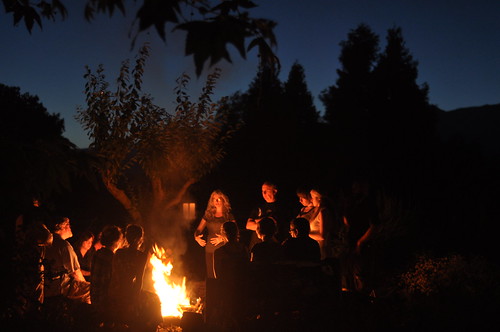It’s been a month since Charletta and I arrived in the Los Angeles airport direct from our time with Christian Peacemaker Teams in Colombia. Now that we’ve caught our breath, I wanted to share with you a window into our first two whirlwind weeks here in the Ojai valley working with Bartimaeus Cooperative Ministries. Charletta and I were part of preparing for and hosting the July Bartimaeus Institute entitled “Rooting Faith: Theology and Practices of Bioregional Discipleship.” I focused on documenting the week for a wider audience through photography and video. This is my first experiment in Youtube journalism. Rather than write a lot about the week, I’ll give a basic introduction and then share the videos that I created:
On the first night of the institute we gathered around the fire to sing songs and talk together at dusk (above). Aside from lodging, the event was hosted by Ched Myers and Elaine Enns in their house and their yard, which is entirely given over to vegetables, fruit trees and native plants. Mornings were spent doing Bible study and studying permaculture and afternoons were spent doing hands on learning of permaculture techniques in the garden. Evenings were practical workshops on a variety of subjects. Chris Grataski and Melissa Shank taught us about permaculture and herbalism.
The Bible studies led by Ched focused on stories from Scripture that highlight the relationship between the Israelites and the places where they lived. Understanding our relationship with the land around us in this way has been mostly lost. For example, in this video Ched looks at the story of Ahab taking Naboth’s vineyard in 1 Kings 21:
However, this wasn’t just about bioregional discipleship as an abstract idea. The institute was in the Ventura river watershed, so we went down the river banks and listened to Elaine share about the story of the river:
We also got our hands dirty in the garden:
Melissa shared about the wise woman tradition of healing that has been nearly lost. This tradition draws on herbal knowledge that was traditionally passed down from mother to daughter over the generations. Melissa talked about the place of this tradition alongside modern medical techniques:
Ched shared a bit about the way we’ve become less aware of the natural spaces we live in:
We did our best to get some time outside the human-built environment by hiking through some of the native Chaparral and oak savanna areas in the valley to learn more about their history:
During the entire week, Dimitri Kadiev and Lisa Slavick worked on a mural telling the story of Elaine’s Russian Mennonite ancestors during the Russian revolution (for more of the story see Pilgrimage to the Ukraine by Elaine). The mural included a Mandala layer that everyone in the institute was invited to add to. This layer that peaks through the final mural layer in a few places:
I did my first ever time-lapse of the mural creation process as it went along:
As always, there are many more photos I took that I didn’t have room for here. I’ll leave with this photos of an oak tree silhouetted against the sunset from Ched and Elaine’s house. White ledge peak is in the background:
P.S. For those of you who made it all the way to the end of the post and wondered what Wolf’ems are, here’s your answer, brought to you by the young theatre prodigy Thomas Apel, of the Guadalupe Catholic Worker. Hint: Wolf’ems ingredients are: fire, a stick, pillsbury biscuit dough, whipped topping and jam:





















1. Can you trace the water you drink from precipitation to tap?Answer:My water comes from the Yocona Water Association, a cmotunimy water distribution network. It is groundwater from the Yocona River watershed, pumped from a well whose exact location I don’t know. I think it is less than a mile from here. They filter the water using chlorine and probably some other chemicals and it tastes NASTY.I have a great new metal roof on my house and I’m fixing to start collecting rainwater. My biggest rainwater catchment challenge is designing my storage cistern. I have an old storm shelter beside the house that has been filled in with dirt. I am considering digging it out and building a fourth wall where the door is to make a complete enclosure. I think it might hold 5000 gallons. I’d like to put a second cistern right on top of it. A food grade plastic top cistern could hold drinkable water while the lower cistern would be used exclusively for irrigation.I’d also like to put in my own well. I discovered an old 3 foot diameter brick well that has been filled. I doubt I’ll be able to get it back into service (it’s probably shallow anyway, and I’d probably want a deep well). Maybe when I have a spare $4,000 kicking around Accepting donations!